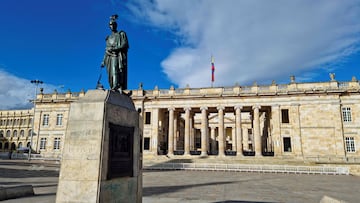HISTORY
When did the Latin American countries gain independence from Spain and Portugal?
The brutal Iberian empires were torn asunder by French invasion during the Napoleonic wars, opening the window for the exploited colonies to rise up.

Spain and Portugal once had two of the largest empires in the globe. Divided by the Treaty of Tordesillas in 1494, the non-Christian world was divided along a meridian 370 leagues west of Cape Verde, near Africa. This entrusted nearly all of the Americas to Spain except Brazil, though at the time there was no accurate way to measure distance or know the true size of the continent.
In the following 300 years both countries, along with other colonial powers like Britain, France, and the Netherlands, expanded their territory in the Americas at the expense of the indigineous people. Huge fleets of gold, silver, and slaves traversed the Atlantic Ocean, making the coffers of monarchs fat while depriving the original holders of the land their birthplace and existence.
The American War of Independence of 1776 and the French Revolution in 1789 heralded the beginning of the modern era of history. The ideas and values espoused by these movements spread into the rest of the Americas just as Spanish and Portuguese power waned.
At the turn of the 19th century, independence fighters such as Simón Bolivar and Miguel Hidalgo led new nations away from Spanish orbit, while the complex dynastic problems in the Portuguese kingdom led to Pedro declaring an independent Brazil. The states left behind were not stable and regularly collapsed, evolving into the map of South America we understand today.
But this wave of revolutionary movement was not just at the beginning of the 19th century. The Spanish prescence in the Caribbean was only ended in 1898 and many nations after this date such as Guyana and Cuba were still not independent until the 20th century. To this day, world powers still cling on to slivers of American territory and regularly deny the democratic will of the people living there.
Latin American nations and their date of independence
The list below features all nations in Latin America including those which are still not independent.
- Colombia - 20 July 1810 (Spain)
- Chile - 18 September 1810 (Spain)
- Paraguay - 14 May 1811 (Spain and then Argentina)
- Venezuela - 5 July 1811 (Spain)
- Argentina - 9 July 1816 (Spain)
- Peru - 28 July 1821 (Spain)
- Costa Rica - 15 September 1821 (Spain, as part of FRCA)
- El Salvador - 15 September 1821 (Spain, as part of FRCA)
- Guatemala - 15 September 1821 (Spain, as part of FRCA)
- Honduras - 15 September 1821 (Spain, as part of FRCA)
- Nicaragua - 15 September 1821 (Spain, as part of FRCA)
- Mexico - 16 September 1821 (Spain)
- Panama - 28 November 1821 (Spain, though governed by Colombia until 1903)
- Ecuador - 10 August 1822 (From Spain)
- Brazil - 7 September 1822 (From Portugal)
- Bolivia - 6 August 1825 (From Spain)
- Uruguay - 25 August 1825 (From Brazil)
- Dominican Republic - 27 February 1844 (Haiti)
- Cuba - 20 May 1902 (From US after Spain in 1898)
- Guyana - 26 May 1966 (From UK)
- Suriname - 25 November 1975 (From Netherlands)
- Belize - 21 September 1981 (From UK)
- French Guiana - ??? (Governed by France)
- Puerto Rico - ??? (Governed by US)






